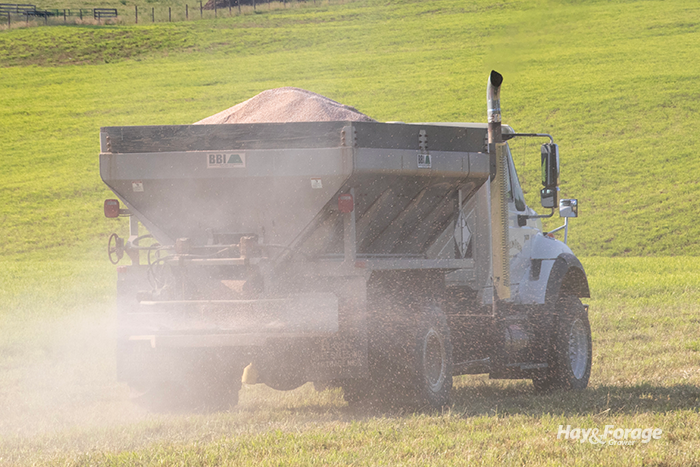High alfalfa yields start here |
| By Mike Rankin, Senior Editor |
|
|
 There are many routes to high-yielding alfalfa, but few of them don’t go down the potassium road. I was reminded of this after reading a recently published five-year study in Agronomy Journal that was done in Wyoming, which again demonstrated the importance of potassium in alfalfa production systems. I’ve been on alfalfa farms that apply no or little potassium and still have great success, but all of these were limited to locations where the underlying subsoil was rich in potassium-containing bedrock. For the rest, potassium is the most important nutrient that needs to be applied for optimum alfalfa production. This is true regardless of the variety you plant or the size of your baler or chopper. The retail price of potash fertilizer (0-0-60/62) currently sits at just over $500 per ton. That price is down from $800 to $900 per ton only two years ago. At the current price, potassium (as K2O) costs about 40 cents per unit. The brutal reality is that alfalfa doesn’t care about the price of potash; it’s going to remove its 55 pounds per ton of dry matter as K2O regardless of cost. “It’s important to remember that forages are a large user of potassium and deficiencies may not be visible,” writes Phil Kaatz in a recent news article. Describing the critical nature of potassium for alfalfa, the Michigan State University Extension field crops educator goes on to say, “The nutrient is needed to facilitate the formation of starch from sugars and protein from amino acids. Sufficient potassium activates over 60 important enzymes in forage plants. It is also arguably the most important soil nutrient for stress tolerance and winterhardiness. Over time, potassium is often the issue with forage stand decline,” he adds. Over the past few years, many alfalfa producers have pumped the brakes on potash applications even though hay prices were at historically high levels. Although reducing input costs was a reasonable response, especially where soil levels were adequate or higher, fields may now be depleted of potassium. Enter a couple of old and reliable friends — the soil test and plant tissue analysis. Having a good set of soil tests to guide potassium fertilizer strategies is critical. The price of potash can never be too high or low that up-to-date soil tests don’t make sense (or cents); both long-term over and under application of potash is costly. If soil test levels are at or below optimum levels, a plant tissue test, which remains underutilized in our industry, is a sure-fire approach to confirm the nutrient status of the crop. It’s an invaluable tool to not only find the cause for nutrient problems, but also to verify that current practices are on target. If you do some plant tissue testing, be aware there is a specific time to take samples and specific plant parts that need to be submitted. Your forage testing lab can provide you with this information. A few years ago, I outlined a real-farm example of how a soil and plant tissue analysis can be used to troubleshoot alfalfa nutrient issues in this article. Livestock complexities There are many variables that influence potassium concentrations in the soil and the plant. Where livestock production is a major enterprise, both manure and corn harvested as silage come into play as significant confounding factors when trying to maintain adequate potassium levels in the soil for alfalfa. Kaatz points out in his article that manure can be an important source of potassium. He also acknowledges and shows data to demonstrate how variable manure potassium can be from farm to farm. Once again, testing is the only way around this reality. Manure is more often applied ahead of a grass crop such as corn to take full benefit of its nitrogen content. This leads us to the second confounding factor — corn silage. The long-term use of corn silage has a large impact on a soil’s potassium status. Corn silage, depending on grain and silage yield levels, will remove at least 100 pounds more potassium (as K2O) per acre than the same crop where only the grain is harvested. This is because most of the potassium is held in the stalk for necessary physiological plant processes. If both alfalfa and corn silage comprise the entire rotation, significant amounts of potassium are being taken off fields. Couple an alfalfa-corn silage rotation with inadequate fertilizer application rates, and it doesn’t take long for soils to become potassium deficient. Potassium deficiency has become a more common occurrence in both alfalfa and in cornfields because potassium removal rates for crop rotations have spiked substantially. These deficiencies are not always noticeable to the naked eye until the situation becomes critical. Finally, consider Dennis Hancock’s seven keys to profitable alfalfa production. Four of the seven keys proposed by the USDA’s Dairy-Forage Research Center director involve some iteration of applying adequate potassium. Get the point? |
